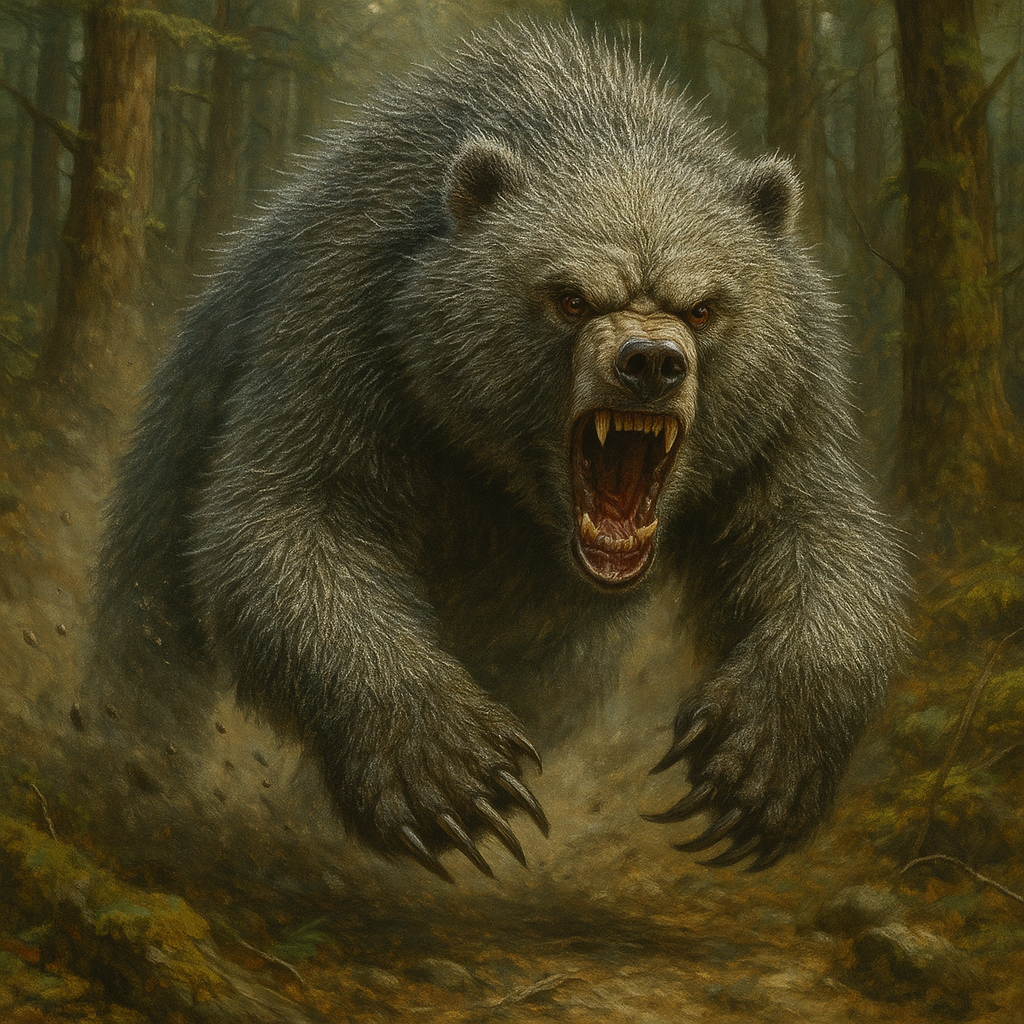Steel Bears
"Don’t touch the fur. You'll pull your hand back looking like a butcher’s broom."
Among the towering trees and moss-slick stone of Everwealth’s northern forests, there lumbers a beast carved not of flesh alone, but fury. The Steel Bear, named for the hard sharpened hairs on it's body that glimmer with metallic sheen, and the sword-like bloodletting it leaves behind; Is a rare offshoot of the common grizzly, larger, angrier, and horrifically more dangerous. An apex predator born of cunning and raw brutality. When this creature charges, the world narrows to a thunderous quake and the whisper of slicing air. Its fur alone can flay a man; its claws will leave none to bury what remains. And though it shares the grizzly’s omnivorous habits, its temperament is far more dire, capable of entering a blind fury at the first sniff of blood or sign of movement, often attacking prey or threats it cannot reasonably defeat such as the dreaded Warchitins. These rages have led to its scattered numbers, but what remains is no less terrible: a walking blood storm, armored in hair.Basic Information
Anatomy
The Steel Bear shares the massive frame and strength of the Everwealthy grizzly, but with several brutal distinctions. Its namesake, belongs to the steel-gray hue of its hide, each hair like a sharpened tendril shimmering faintly when caught in direct light, resembling flexible metallic fibers more than any naturally growing hair, capable of slicing exposed skin with the slightest graze. This makes physical contact deadly; even brushing past one during a charge can leave a victim shredded. In combat, the Steel Bear’s mauling technique is amplified by the thousand cuts its fur delivers. Teeth and claws are secondary to its rolling, wrestling form, grappling prey and grinding them into ribbons beneath its crushing bulk. Its claws are slightly longer than a standard bear’s, and its teeth jagged rather than curved, allowing for tearing rather than holding. The eyes are smaller, often sunken, but become bloodshot in its frenzied state, a phenomenon attributed to a magickal inflammation of the blood.
Genetics and Reproduction
Steel Bears breed infrequently, with solitary females entering heat once every three years. Males will challenge each other in brutal displays, often leading to death. Cubs are born in twos, rarely threes, and raised for up to two years before the mother drives them off.
Growth Rate & Stages
- Cub (0-1 year): Covered in dull gray fuzz; relatively docile.
- Adolescent (1-3 years): Begins developing needle-tipped fur and independent aggression.
- Mature (3+ years): Fully grown; dominant behavior sets in.
Ecology and Habitats
Steel Bears are found exclusively in Everwealth’s colder, temperate woodlands, most notably:
- Northern edges of The Grandgleam Forest.
Dietary Needs and Habits
Omnivorous, with a diet including:
- Deer, elk, and wild boar.
- River fish.
- Roots, berries, moss, carrion.
Biological Cycle
Steel Bears do not hibernate traditionally. Instead, they enter a slowed torpor from late frost to first thaw, occasionally waking during blood-heavy snowmelt seasons. During mating season, they are especially volatile, known to kill any creature within scent range of their dens.
Behaviour
While solitary and generally non-territorial, Steel Bears become dangerously aggressive when hungry or blood-scented. Once triggered, they enter a frenzied state known as a rage-trance, wherein their pain response dampens and they will pursue prey or foes regardless of logic. This makes them feared even by other apex predators.
Additional Information
Perception and Sensory Capabilities
Their sense of smell is unmatched in forested biomes, able to detect prey up to two miles away. Hearing is average, but their low rumbling growl has been known to carry across valleys. Their sight is limited, but they can perceive heat signatures during blood-rage, leading some to believe their rage is partially arcane in nature.
Scientific Name
Ursus lamina ferox.
Origin/Ancestry
Believed to have descended from a pre-Schism bloodline of bears that drank from iron-rich waters corrupted by residual battlefield magicks. The fusion of arcane and mineral environments caused generations of fur calcification.
Conservation Status
Rare, though not endangered. Their own recklessly aggressive hunting behavior limits their population. Hunted not for meat, but for hide, valuable in forging bladecloth armor, though harvesting it is nearly suicidal.
Geographic Distribution



Comments